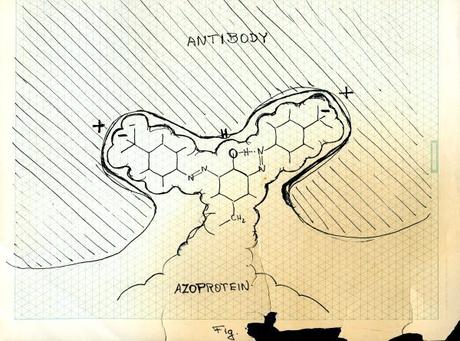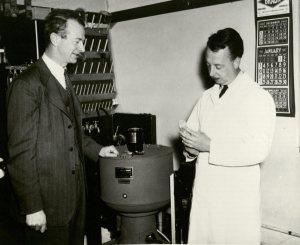
Drawings of the interaction between an antibody and azoprotein by Linus Pauling. 1940s.
Dan Campbell first collaborated with Linus Pauling on a fellowship at Caltech in 1940, during which time the duo tried to explain how antibodies are formed. At the time, Pauling believed that antibodies were proteins in-the-making that needed to bind to antigens in order to fold and complete their structure. If this principle was correct, Pauling thought, it might be possible to create artificial antibodies by simply denaturing proteins and allowing them to bind and refold in the presence of antigens.
Despite the fact that Campbell’s initial test results cast doubt on his collaborator’s theories, Pauling went ahead and published his ideas on how antibodies work, hoping that further research could support his paper. Thus began a lengthy study of antigen-antibody binding in which Pauling and Campbell attempted to develop a complete theory. Along the way, Dan Campbell’s research at Caltech would become very important to the Institute as well as to Pauling.
In 1943 a Caltech research fellow named David Pressman agreed to join Campbell and Pauling in their study of immunology. Starting with work that had previously been published, Pressman, Pauling and Campbell refocused their studies to explain how antigens and antibodies bind, a change in focus from Campbell and Pauling’s earlier inquiries into how antibodies and antigens are formed. The decision to focus on previous research was made after Pauling had mistakenly announced that antibodies had successfully been synthesized at the Gates and Crellin Laboratories. As it turned out, attempts to create synthetic antibodies using Pauling’s proposed methods were completely unsuccessful. Pauling thus decided to start from scratch by developing a theory of antigen-antibody binding, which he would use to further investigate the chemistry of this interaction.
In July 1943, the three men published “The Nature of the Forces Between Antigen and Antibody and of the Precipitation Reaction,” appearing in the journal Physiological Reviews. The paper attempted to make more educated predictions about antigen-antibody binding. In doing so, the article begins by referencing the concept of structural complementarity, which posits that antigen-antibody binding is driven by the close complementary physical shapes of the two molecules, which fit together like two adjoining pieces in a jigsaw puzzle. Commonly referred to as “the lock and key mechanism,” this idea was developed in the early 1930s, and served as Pauling and Campbell’s starting point in their initial investigations.
The 1943 study also drew from outside theories, such as the framework theory of precipitation, to suggest that antigen-antibody binding results in the formation of a precipitate; that is, that the two structures react to form an insoluble compound. Using these points as their foundation, the three researchers developed a new theory of antigen-antibody binding.

Pauling and Campbell, 1943.
Campbell, Pressman and Pauling’s breakthrough came by way of their proposal that structural complementarity is an especially important feature for reactions that depend on Van der Waals forces. Van der Waals forces are weak forces of attraction that bind together molecules located in close proximity to one another. The Caltech researchers believed that the close complementary geometry of antibodies and antigens was significant enough to enable these molecules to fit together using the weak Van der Waals attraction as a binding force. In other words, the summation of Van der Waals forces present along the binding site of an antibody worked to bind it to its antigen, specifically because the shapes of antibodies and antigens complimented each other so closely. This theory explained much of what had been observed by immunologists across the discipline in multiple investigations of antigen-antibody reactions.
From here, the three researchers also asserted that two propositions placed forth in Pauling’s 1940 paper should still be considered for further study: the multivalence of antigen-antibody interactions and the probability of hydrogen bonds acting between the two molecules. The trio also concluded that the antigen-antibody mechanism would require at least two supplementary types of forces: Coulomb attraction and polar attraction.
Of the conclusions published by Campbell, Pressman and Pauling in 1943, the multivalence of antigen-antibody interactions and the three proposed forces (Van der Waals, Coulomb and polar) between the two molecules are still considered to be contributing factors to the functioning of the human immune system. With this publication, Campbell, Pauling and Pressman also showed that the immune system relies heavily on both structural and chemical features to carry out its processes.
The important conclusions derived from research conducted by Campbell, Pauling and others established Caltech as a leader in the field of immunology. Over the years that followed, Campbell and Pauling continued to develop their theory of antibody formation, which remained widely accepted until the 1950s. Even when the duo’s work began to be disproven by findings in the genetics field, the understanding of antigen-antibody interactions suggested by research done at Caltech remained undisputed.
Dan Campbell and Linus Pauling went on to publish more than twenty articles relating to immunology, exchanging ideas on the topic until the end of Pauling’s tenure at Caltech in the early 1960s. The attention that their work brought to the Gates and Crellin Laboratories at Caltech prompted the creation of a separate department, one that was entirely dedicated to immunochemistry. (The first of its kind on the west coast.)
For thirty years, Campbell headed Caltech’s immunochemical research and his fame as an immunologist grew to the point where, in 1972, he was named president of the American Association of Immunologists. Two years later, in 1974, Campbell passed away at the age of 67, the victim of a heart attack. Over the course of his career, he published more than 200 papers as well as several books, and he served on editorial boards of four scientific journals related to immunology.
